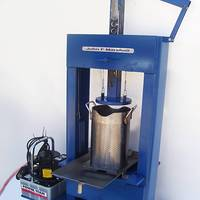Vegetable Oil Production
Overview
OSE principles suggest minimal use of petroleum products, which often means the substitution of locally produced vegetable oils. Oil crops are also likely to be grown for edible cooking oils. In either case, appropriately-scaled oil processing technology is required.
Applications
- Cooking oil
- Hydraulic fluid
- Motor fuel, as in (Biodiesel) and Pure plant oil as fuel
- Lubricating oil (e.g. [1][2])
- Paints/coatings
- Electrical dielectric fluid [3],(IEEE tutorial)
Crops
Processes
Small scale processing paper from ATTRA
Oilseed pressing on Appropedia
Description of conventional Refined/Bleached/Deodorized(RBD) process in this patent application
The cage press method of expressing oil involves loading seed into a squeezing compartment, applying at least 500psi (higher pressures, up to thousands of psi, improve extraction efficiency) to crush seed and express the liquid oil, then removing the remaining solid oilcake. It seems that with appropriate simple modifications (a perforated pusher block above the moving press foot) the CEB Press could perform this function very effectively.
Separating Oil from Aqueous Extraction Fractions of Soybean examines the use of aqueous (basic) sodium hydroxide solutions for extraction of oil from soybeans processed with different means. A sodium hydroxide mixture is found to be 80-90% efficient but processing to lyse cells is key to a high yield. Lipid droplets are also complexed with lipid binding proteins (oleosin) which can complicate downstream processing.



